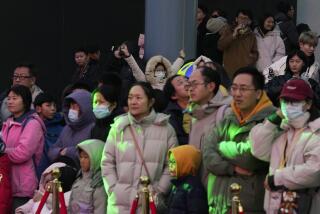On the Ground: Ushering in the Year of the Monkey at 180 mph on China’s bullet train
Packed to capacity, the Harmony No. 1 bullet train slides out of West Rail Station into Beijing’s crisp, snow-dusted suburbs on the first day of the Year of the Monkey. A bright morning sun perches high in the blue February sky, given a holiday reprieve from the belching of smokestacks and car tailpipes on the Chinese capital’s oft-clogged highways.
The city stands still with a preternatural calm, as if stunned by the sudden exodus of millions of its sons and daughters.
We stragglers on Train G609 are among the last to depart. By the window in Car 13, Row 6, slumps a fiftysomething migrant construction worker who introduces himself as “Old Wang”; he had waited too long to buy a ticket and found all the New Year’s Eve seats, for the day before, sold out.
Along the aisle sit 2-year-old Lulu and her mother, Yang Mei, whose travels had been delayed by her husband’s work obligations at an accounting firm.
Like nearly everyone aboard, they are heading to their hometowns for Spring Festival, a holiday freighted with such deep family obligations that it touches off what is known as the greatest human migration on Earth. By air, by road and by rail, Chinese are expected to make 2.91 billion trips over the full 40-day period that began Jan. 24 this year. Some 332 million of them will be by train, up almost 13% over last year.
Nearly half will be on trains like the Harmony No. 1. Nine years ago, China had not one such bullet train in service.
A cartoon woman pops onto the onboard TV screens and begins reciting some statistics. “By the end of 2015, China had 19,000 kilometers of high speed track in operation, the most in the world,” she says in a school-teacher voice. “That is over 60% of all high speed rail in the world….”
An orange digital display at the front of the car tracks our acceleration: 290 km/h, 291 km/h, 297 km/h. (That’s 180-181 mph, by the way.)
Old Wang sits up, takes a swig of peanut milk and glances at his mobile phone. It’s his first time on Harmony No. 1, and there are only two numbers that matter to him.
“Five hours to Houma,” he pronounces with a smile, revealing his nearly toothless bottom jaw. “Before, it used to be 16.”
+++
My destination, the ancient walled city of Pingyao, 444 miles southwest of Beijing, will come an hour before Houma. Along the way, we will gain almost 2,800 feet of elevation as Harmony No. 1 sails through the barren cornfields of Hebei province, into the notoriously polluted city of Shijiazhuang, up through the Taihang Mountains and onto the dusty yellow plateau of Shanxi province, the heart of China’s coal country.
As we leave Shijiazhuang, an attendant in a pink uniform pushes a cart down the aisle. “Beef noodles! Snacks!” she calls. The cartoon lady on the TV launches into some train etiquette tips. “Don’t throw food waste into the toilet…. Don’t hog seats in the station waiting area by lying down across them and sleeping.”
China’s bullet trains are affordable enough to attract passengers even from society’s lower rungs. They offer business-, first- and second-class seats, and while fares for second class are typically at least twice what a “slow” train would cost, they are not out of reach for workers like Old Wang.
During the Spring Festival travel peak, a one-way fare from Beijing to Pingyao costs about $28 and takes four hours. The slowest, cheapest train, whose journey can stretch 15 hours, costs $14.
Shortly after noon, Lulu breaks into her third chocolate snack of the trip, an egg-shaped confection from Germany. Old Wang needs a sugar fix himself. He cracks open another bottle of peanut milk and pulls a plastic bag of muffins from his rucksack. “Want one?” he offers.
+++
Not far out of Shijiazhuang, Harmony No. 1 begins to decelerate. The orange display ticks downward: 297 km/hr, 249 km/hr, 218 km/hr, 179 km/hr. On the horizon, dusty beige hills materialize.
The train plunges into a tunnel. On the TV, the broadcast has switched to a propaganda segment extolling “Core Socialist Values.” Old Wang reclines his seat and closes his eyes.
The darkness seems to be stretching on forever. We emerge, briefly, into the sunlight, only to delve again into darkness. This time, I set my stopwatch. One minute goes by, then two, then three.
A brief flash of light, and we are back underground yet again. This darkness feels interminable. Staring at my stopwatch, my mind drifts back to my fourth-grade math class.
A train is traveling at 179 kilometers per hour through a tunnel. The train takes 9 minutes and 20 seconds to pass through the tunnel. How long is it?
I double-check my stopwatch. I do some mental arithmetic. If we really are going 179 km/hour, that’s 111 miles per hour. Which means that this tunnel is 17.29 miles long.
That’s farther than going from downtown L.A. to LAX on the 110 and 105 freeways.
The TV is playing a video of China’s most recent rocket launch. Lulu and Yang Mei are sleeping now, too. No one aboard Car 13 seems to take notice of China’s feats in space, or underground.
Amid China’s breakneck development, one mind-blowing accomplishment quickly blurs into the next. Yes, Taihang Tunnel is currently China’s longest rail tunnel, but it won’t be for long. It will soon drop to No. 3 with the opening of the 20.28-mile Xinguanjiao Tunnel in Qinghai province, and the 17.54-mile West Qinling Tunnel in Gansu.
As we near Pingyao, I start to gather my things. Old Wang wakes up.
“We went through a really long tunnel,” I mention as I stand up to disembark. “Nine minutes.”
Old Wang shrugs. “Really? I don’t know,” he says. “I just know I’m getting home faster.”
Follow @JulieMakLAT on Twitter
Special correspondent Chuan Xu and Nicole Liu in The Times’ Beijing bureau contributed to this report.
More to Read
Start your day right
Sign up for Essential California for news, features and recommendations from the L.A. Times and beyond in your inbox six days a week.
You may occasionally receive promotional content from the Los Angeles Times.







